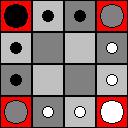Hibryd I
By Jared B. McComb
Introduction

|
Hibryd I is played on the board shown at left. It is a game between two players, Black and White, with the addition of two Gray pieces, which are neutral. On the board, there are six light squares, six dark squares, and four red squares. |
Setup

|
The opening setup is shown here. Each player has one king, shown by a large circle, and four pawns, shown by small circles. The neutral pieces are shown as gray circles. |
Pieces
The Kings may move one space orthogonally or diagonally. They are the only pieces that can capture by replacement, and may only do so when capturing a neutral piece. The kings may also aid friendly pawns in capturing neutral pieces. The kings are obliged to move out of check whenever necessary, except with regard to the 'counter' rule (see below).The Pawns may move one space orthogonally. They can capture neutral pieces by custodianship, either orthogonally or diagonally, like an 8-directional Pincer Pawn. They may also capture Kings by replacement.
The Neutral pieces may move one space diagonally. They may also move one space orthogonally, provided that the move either starts or ends on a red square. They may be used by a player to check an opposing king. If a neutral piece moves into a space where it would be captured by a pair of friendly pawns, it is considered to have been captured by the player who owns the pawns and is removed from the board. If it would have been captured by both players simultaneously, it is taken by the player who moved it. This is called neutral suicide.
Play
Once turn order is decided (by any means agreeable to both players), and each player has selected a faction to use, play begins. On their turn, a player must move a friendly piece, and may optionally move a neutral piece afterwards.
Objectives
A player may win in any of the following ways:
- Capture (not necessarily checkmate) the opposing king.
- Arrange your four pawns in a straight line, either orthogonally or diagonally.
- Maneuver your four pawns onto all four red squares.
- Move your king to the opposing king's starting square.
- Capture both neutral pieces.
- Immobilize the opponent.
Ways 1, 2, and 4 may all be countered; that is, if your opponent succeeds in doing one of these, and you could do the same thing on your next turn, in doing so you would nullify the winning move, and that method of winning cannot be used anymore (until the next game). A draw occurs either by all of the ways of winning being nullified, or by mutual agreement of both players.
Strategy
The neutral pieces are going to go fast, so try to get one of them to keep your opponent from winning. It is easiest to get them by moving them between your pieces, rather than the other way around.
Although this game has been playtested a lot, I am still clueless as to much of the strategy. If you come up with any more, please drop me a line at the address listed below.
Variant
Proto-Hibryd: Play without neutral pieces or counters. This is the game that eventually gave rise to the Hibryd on this page.
Credits
This game was inspired mostly by Krieg, a small pseudo-CV played on a 4x4 board with 4 pieces per side. I also borrowed elements from Neutron, Chess (of course), Tafl, and Morris.
Special thanks go to Andy Siegert, a friend of mine and definite Hibryd fanatic.
Please send all questions, comments, constructive criticisms, better diagrams, computer programs that play this game (freeware only please!), etc., to
Written by Jared B. McComb. HTML Conversion by Peter Aronson.
WWW page created: February 24th, 2002.